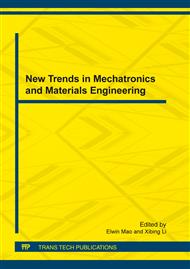[1]
G. M. Nielson, L. Y. Zhang, K. Lee and A. Huang, Spherical parameterization of marching cubes isoSurfaces based upon nearest neighbor coordinates, Journal of Computer Science and Technology. 24 (2009) 30-38.
DOI: 10.1007/s11390-009-9201-z
Google Scholar
[2]
C. Y. Chen et al, A sharpness-dependent filter for recovering sharp features in repaired 3D mesh models, IEEE Transactions on Visualization and Computer Graphics. 14 (2008) 200-212.
DOI: 10.1109/tvcg.2007.70625
Google Scholar
[3]
K. Tamal, T. K. Dey and J. Levine, Delaunay meshing of isosurfaces, Visual Comput. 24 (2008) 411–422.
DOI: 10.1007/s00371-008-0224-1
Google Scholar
[4]
S. P. Peer, L. J. Latecki and M. Siqueira, Topological equivalence between a 3D object and the reconstruction of its digital image, IEEE Transactions on Pattern Analysis and Machine Intelligence. 29 (2007) 126-140.
DOI: 10.1109/tpami.2007.250604
Google Scholar
[5]
G. Dziuk and C. M. Elliott, An Eulerian approach to transport and diffusion on evolving implicit surfaces, Comput Visual Sci. 13 (2010) 17–28.
DOI: 10.1007/s00791-008-0122-0
Google Scholar
[6]
C. Y. Chen et al, A sharpness-dependent filter for recovering sharp features in repaired 3D mesh models, IEEE Transactions on Visualization and Computer Graphics. 14 (2008) 200-212.
DOI: 10.1109/tvcg.2007.70625
Google Scholar
[7]
I. Tobor, P. Reuter, and C. Schlick, Efficient reconstruction of large scattered geometric datasets using the partition of unity and radial basis functions, WSCG. 12 (2004) 467-474.
Google Scholar
[8]
S. Ilic and P. Fua, Implicit meshes for surface reconstruction, IEEE Transactions on Pattern Analysis and Machine Intelligence. 28 (2006) 328-333.
DOI: 10.1109/tpami.2006.37
Google Scholar
[9]
Y. D. Zhang, Y. J. Liu and X. F. Dai, Categories and new developments of three-dimensional reconstruction using triangulation mesh, ICIC Express Letters. 5 (2011) 95-100.
Google Scholar
[10]
H. Hopp, T. Derose, T. Duchamp, J. McDonald, and W. Stuetzle, Surface reconstruction from unorganized points. Proceedings of ACM SIGGRAPH. (1992) 71-78.
DOI: 10.1145/142920.134011
Google Scholar
[11]
T. Taniguchi and K. Moriwaki, Automatic mesh generation for 3D FEM- robust Delaunay triangulation, Tokyo: Morikita, (2006).
Google Scholar
[12]
A. C. Jalba et al, Effient surface reconstruction using generalized coulomb potentials, IEEE Transcations on Visualzation and Computer Graphics. 13 (2007) 1512-1519.
DOI: 10.1109/tvcg.2007.70553
Google Scholar
[13]
G. Guennebaud and M. Gross, Algebraic point set surfaces, ACM Transactions on Graphics (SIGGRAPH 2007 Proceedings). 26 (2007) 23. 1-23. 9.
DOI: 10.1145/1276377.1276406
Google Scholar
[14]
M. S. Abdel Wahab, A. S. Hussein et al, Distributed reconstruction of implicit surfaces, , International Conference on Computer Engineering and Systems, Cairo, Egypt. (2006) 7-13.
Google Scholar
[15]
Y. L. Chen and S. H. Lai, A partition-of-unity based algorithm for implicit surface reconstruction using belief propagation, IEEE International Conference on Shape Modeling and Applications, Minneapolis, MN, USA. (2007) 147-155.
DOI: 10.1109/smi.2007.3
Google Scholar


